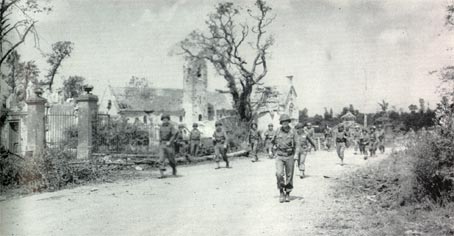| |
The 35th Division went into battle near the River Vire just North
of the tiny village of La Meauffe about seven miles North of St.
Lo and along a 5,000 yard front. The days that followed were among
the most difficult of the entire war, with specially heavy losses
to officers and non-coms, most of whom were highly trained and skilled.
Units took huge losses of personnel who in many cases had been in
the service since 1940. Replacements who came thereafter rarely
had much more than thirteen weeks of infantry training. After St.
Lo, units were never the same.

35th at La Meauffe on Vire River.
Let us follow the experience of the 137th Infantry
Regiment, a good, typical National Guard based
unit as it entered combat. 6 a.m., July 11th,
H-hour. We begin a cautious approach attack following
a heavy barrage and are immediately met with point
blank surprise fire. Take cover and begin again
a hazardous, laborious, slow forward movement
of a few men at a time, a few yards, fire and
movement – only you can’t see where
the enemy is firing from, follow the hedgerow,
use grenades, hand to hand combat. One area is
defended by individual pillboxes and small nests
of resistance. The G.I.s call it “Purple
Heart Corner” for good reason. It is the
solid stone chateau up ahead, formerly a Gestapo
headquarters, now studded with machine guns. On
beyond is St. Gilles and the church and another
chateau, this one with eighteen inch sandstone
walls and a 50 foot bell tower.
Disaster strikes quickly. A few minutes after
the attack begins, Col. Grant Layng from Connecticut,
Commanding Officer of the 137th Infantry lies
severely wounded. The Assistant Division Commander,
Gen. Edward Sebree, takes command, Lt. Col. John
Wilson, C.O. of the 219th Field Artillery and
Capt. John Kerr, Artillery Liaison Officer, are
killed. Forward movement is slow. Casualties at
the end of the first day, 126, of whom 12 are
killed, 18 missing in action. Second day –
intermittent rain but the attack inches forward
with help from the 448th Anti-Aircraft Battalion
and the 654th Tank Destroyer Battalion. Casualties
– 88, of whom 7 are KIA, 7 MIA’s.
Third day – 500 yard advance at a cost of
125 more casualties – 21 KIA, 17 MIA. Prisoners
taken include Polish, Russian and Czechoslovakian
under German officers. Loud speakers brought in
for psychological warfare. Leaflets spread over
the enemy lines urging surrender. Not much luck
there. Fourth day, attack continues. 737th Tank
Battalion arrives and helps 137th overcome several
fortified stone buildings. Cover some ground but
lost 127 men including 17 KIA and 4 MIA. Fifth
day – forward movement a little better.
Casualties – 117, including 16 KIA, 1 MIA.
The 320th Infantry Regiment, led by Col. Bernard
A. Byrne, also a West Point graduate, intelligent,
well-liked, gentlemanly, eternally optimistic,
commanded the regiment during its training and
all through its combat, met stiff resistance each
day with similar results and similar casualties.
One day progress was limited to 300 yards total.
 Continue
to Page 4 of 4 Continue
to Page 4 of 4
|